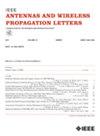An Aperture Efficiency Enhancement Method for Transmitarray Antenna by Exploiting Dual Metasurfaces Modulation
IF 4.8
2区 计算机科学
Q2 ENGINEERING, ELECTRICAL & ELECTRONIC
引用次数: 0
Abstract
This letter presents a systematic method for improving the aperture efficiency (AE) of transmitarray antenna (TA) without increasing the profile through modulation of dual metasurface transmitarrays. The first metasurface transmitarray intercepts more energy from the feed source and redistributes the intercepted energy over the second transmitarray through phase modulation, thereby improving spillover and taper efficiencies simultaneously. The phase efficiency is improved through the modulation of second metasurface transmitarray. The method overcomes mutual constraint between spillover efficiency and taper efficiency in traditional TA with single metasurface TA (TA-SM). To demonstrate the effectiveness of the method, two TAs [termed as TA-SM and dual metasurface TA (TA-DM)] with identical focal-length-to-diameter (F/D) of 0.625 are designed, fabricated, measured, and compared. The TA-SM with single transmitarray is a traditional TA with optimal AE, and the TA-DM with dual transmitarrays is designed based on the proposed method. Finally, at 14 GHz, the TA-DM realizes peak AE of 67.8利用双超表面调制提高发射阵列天线孔径效率的方法
本文提出了一种系统的方法,通过对双超表面发射阵列进行调制,在不增加天线轮廓的情况下提高发射阵列天线的孔径效率。第一超表面发射阵列从馈电源截获更多的能量,并通过相位调制将截获的能量重新分配给第二发射阵列,从而同时提高溢出和锥度效率。通过对第二超表面发射阵列的调制,提高了相位效率。该方法克服了传统的单超表面技术中溢出效率和锥度效率之间的相互约束。为了证明该方法的有效性,设计、制造、测量和比较了两个具有相同焦距-直径比(F/D)为0.625的TA[称为TA- sm和双超表面TA (TA- dm)]。单发射阵TA- sm是传统的最优声发射TA,双发射阵TA- dm基于该方法进行了设计。最后,在14 GHz时,TA-DM在低轮廓(F/D=0.625)下实现了67.8$\%$的峰值AE,与TA-SM(47.2$\%$)相比实现了20.6$\%$的最大AE改进。此外,TA-DM的1db增益带宽为22.9%。该方法可用于远距离通信中高增益、低轮廓天线的设计。
本文章由计算机程序翻译,如有差异,请以英文原文为准。
求助全文
约1分钟内获得全文
求助全文
来源期刊
CiteScore
8.00
自引率
9.50%
发文量
529
审稿时长
1.0 months
期刊介绍:
IEEE Antennas and Wireless Propagation Letters (AWP Letters) is devoted to the rapid electronic publication of short manuscripts in the technical areas of Antennas and Wireless Propagation. These are areas of competence for the IEEE Antennas and Propagation Society (AP-S). AWPL aims to be one of the "fastest" journals among IEEE publications. This means that for papers that are eventually accepted, it is intended that an author may expect his or her paper to appear in IEEE Xplore, on average, around two months after submission.

 求助内容:
求助内容: 应助结果提醒方式:
应助结果提醒方式:


